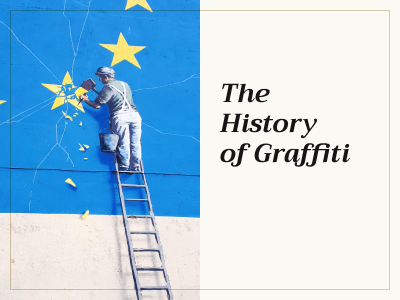Although associated with young people scribbling explicit words on walls in the middle of the night, graffiti is not a modern invention.
While the modern style we are familiar with today originates from the 1960s and 70s, graffiti has existed since ancient times and has had significant cultural and historical implications throughout the years.
Ancient Graffiti
The word graffiti stems from the Greek word graphein, meaning to write. It originally referred to inscriptions and drawings found on the walls of ruins before evolving to include any sort of vandalism.
Although classed as more of a nuisance than anything today, graffiti has played an important part in history. The Safraitic language, an ancient form of Arabic, is only found in graffiti etched onto rocks and boulders in areas in Syria, Jordan, and Saudi Arabia.
Graffiti also gives historians a rare insight into the lives and cultures of ancient society. For example, the first instance of what could be classed as modern graffiti consists of a footprint, a hand that resembles a heart, a number, and a woman's head, which guides theorise is an advertisement for prostitution. Numerous examples of graffiti exist in the ruins of Pompeii, ranging from spells, insults, slogans, and crude drawings.
One piece of graffiti on the wall of a tavern in Pompeii complains about the tavern owner and his watered-down wine, and another gives the address of a prostitute who was in high demand at the time. Another inscription complains of lost love and describes the writer's desire to hit Venus over the head because of his heartbreak.
Graffiti has also been found in Mayan societies, and Viking graffiti has been found in Rome. It has also been etched into landmarks across America, such as Independence Rock, where people scratched their names in the 1800s.
Contemporary Graffiti
During the Second World War, graffiti bearing the phrase “Kilroy was here” spread worldwide. Historians are unsure where the expression and drawing originated, but it is theorised that it is a combination of British and American sources.
The character that accompanied the phrase, a bald man with a prominent nose peeking over a wall, is thought to have been taken from a British cartoonist. “Kilroy was here” may have originated from an American shipyard inspector who marked his work with the phrase to avoid riveters being paid twice for their work. However, there is a non-definitive answer. Nevertheless, the graffiti has been hailed for symbolising Allied unity during the war.
In the 1970s and 80s, what we know as graffiti today began to emerge. The invention of aerosol paint in 1949 made tagging and graffiti more accessible, and the punk and rock-and-roll scenes encouraged fans to graffiti clubs and squats. Emerging street artists also began to utilise wheatpaste posters that they transformed into art and used to promote their public image.
Hip hop culture encouraged the growth of graffiti, and the two became synonymous in 1980s New York. At the same time, the emergence of stencilled graffiti was just beginning, with Blek le Rat stencilling rats around France. This style is now widely known as being favoured by Banksy, who famously stated that every time he thought he had done something original, he found out that Blek le Rat had done it twenty years earlier.
In the 1990s, graffiti rose as an overtly politicised art form. Many artists used techniques such as subvertising, which included taking an advertisement and subverting it to turn the public's attention in another direction. Some also utilised culture jamming, a similar technique to subvertising that used mass media to produce a commentary on itself.
The art of graffiti continued to develop into the 2000s with the creation of reverse graffiti. Credited to English Artist Paul Curtis, who discovered the technique at his dishwashing job, reverse graffiti creates semi-permanent images on walls and surfaces by removing dirt. Advocates of reverse graffiti hail it as being environmentally friendly as it does not use aerosol paints and can be done with biodegradable materials.
In recent years, graffiti and street art have been injected into popular culture, with many brands and even local councils commissioning artists to create graffiti pieces for them. However, using graffiti for commercial purposes is controversial today, as many feel that tolerating graffiti in one place leads to illegal graffiti in other places.
Graffiti artists themselves have also had mixed reactions to the commercialisation of graffiti. Some view it as 'selling out', whereas others enjoy creating art for companies that are seen on a global scale.
The advent of the internet has also completely changed the world of graffiti. Where some styles could only be found in specific areas, the internet allowed artists to upload and share their work and collaborate with others around the world.
Conclusion
The history of graffiti and street art is rich and varied. Ancient societies used graffiti as advertisements, to express their emotions, and to mark that they were there. Contemporary graffiti operates in almost the same way.
From its roots in the ancient world to its prevalence in modern society, graffiti will always have a place within society.
